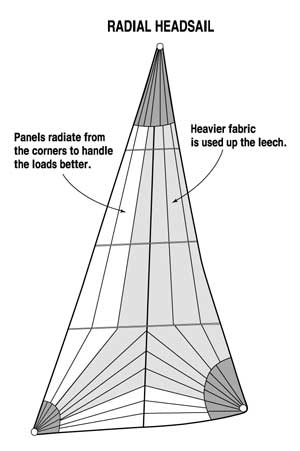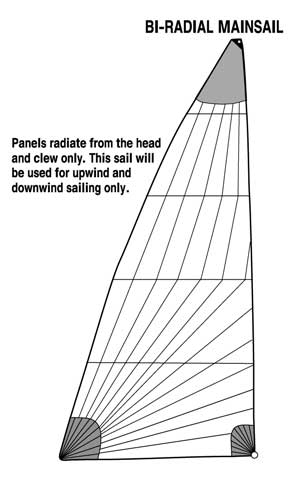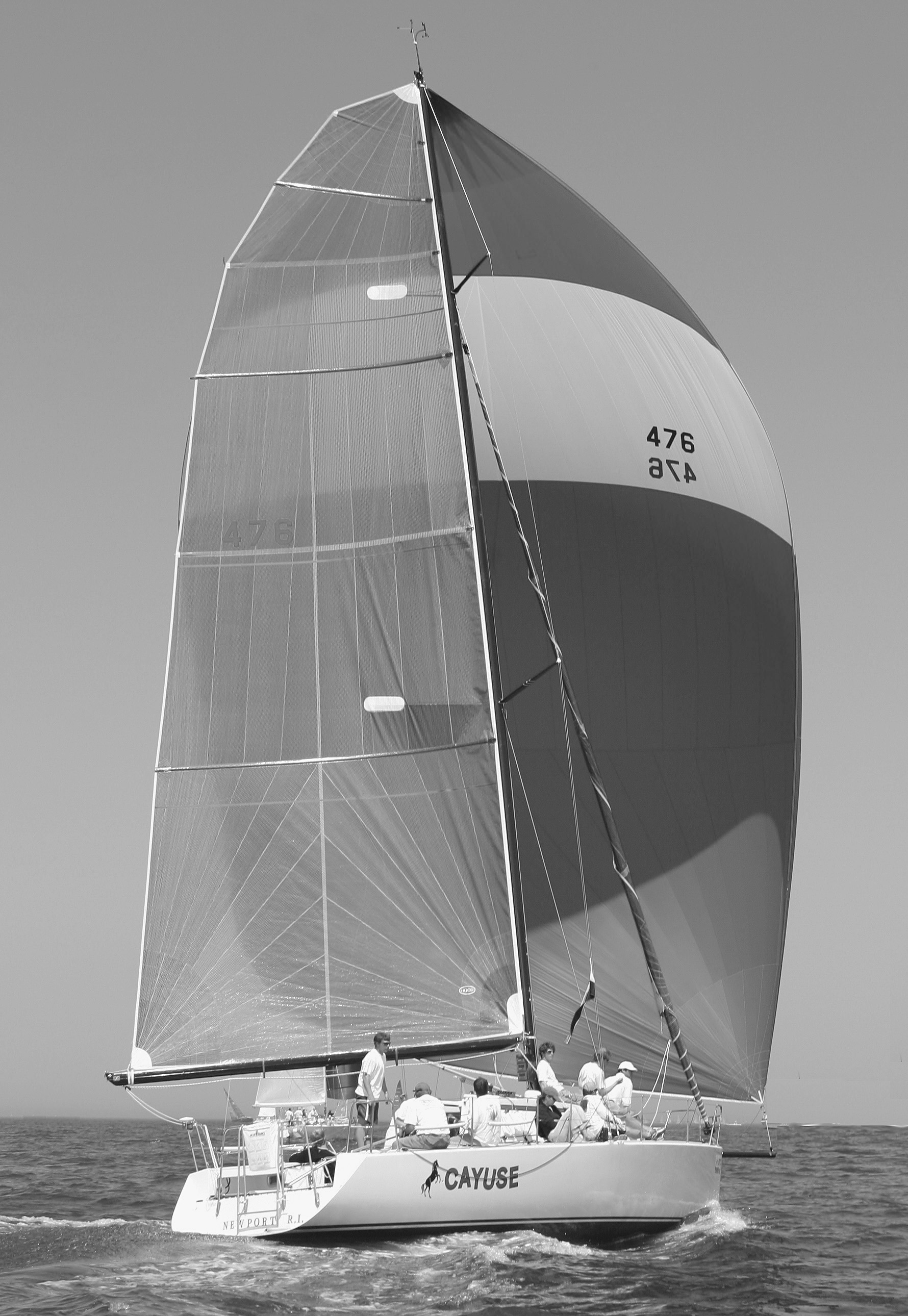 |
| Figure 4.10 Warp-oriented laminates were used to build radial sails, i.e., sails in which the panels were oriented along the load lines, not just stacked up parallel to the foot. |
Excerpt from Maximum Sail Power:
The Complete Guide to Sails, Sail
Technology and Performance
by Brian Hancock
(Nomad Press, $44.95). Copyright 2003.
All rights reserved.
A
PRIMER OF PANEL LAYOUTS
Part one of A Primer of Panel Layouts
began in the July 2004 issue of Northern
Breezes.
Radial Sails
While cross-cut sails were built from
woven Dacron, laminated fabrics allowed
sailmakers to build both cross-cut and
radial sails depending on how the fabric
was engineered. When the fabrics were
laminated the scrims were laid so that
the strength in the fabric could run in
the warp direction, the fill direction
or both. Fill-oriented laminates were
still used to build cross-cut sails,
while warp-oriented laminates were used
to build radial sails, i.e., sails in
which the panels were not just stacked
up parallel to the foot. (Figure 4.10)
Sailmakers had been building tri-radial
spinnakers for some time so the concept
of orienting the panels along the load
lines was not new. It was just that this
was the first time they could build
working sails with a tri-radial panel
configuration.
 |
| Figure 4.10 Warp-oriented laminates were used to build radial sails, i.e., sails in which the panels were oriented along the load lines, not just stacked up parallel to the foot. |
One of the principal benefits of radial
sails is that the sail designer can
engineer sails with different fabrics in
different areas of the sail to address
specific loads. In other words, heavier
fabrics can be used along the leech of
the sail or at the head and clew where
loads are highest, while lighter fabrics
can be used in lower load areas like the
luff. These fabrics can differ in terms
of overall weight and specific lay-up.
They can also differ in terms of the
types of fibers and yarns used to carry
the load. For example, the sailmaker can
design the sail with low-stretch Kevlar
yarns in the high load areas and a
regular polyester in the rest of the
sail. In doing so, he can keep the cost
of the sail to a minimum while still
gaining the maximum benefit from the
exotic fibers. If the sail is going to
be used on a race course, the sailmaker
can add durable, chafe-resistant panels
through the foot area to take the abuse
handed out each time the boat tacked. If
the sail is going to be used for long
cruising passages similar patches can be
used in other high-chafe areas, for
example, where a mainsail rubs against
shrouds or spreaders. The same can be
done for woven cross-cut sails but the
patches are added on later.
Incorporating them in the original
design is a more efficient way to build
a sail.
Mainsails and Bi-Radial Sails
Of course, sails are used not only for
sailing upwind, but on reaches and runs
as well. Mainsails in particular have to
able to perform on every point of sail.
Some boats, like those that compete in
Olympic events, the America’s Cup or
other inshore events, spend most of
their time sailing either hard on the
wind, or sailing deep off the wind,
while others, like those that compete in
long-distance offshore events spend much
of their time reaching and running. Much
like headsails, when sailing hard on the
wind the principal loads on a mainsail
go directly from the mainsheet onto the
clew of the sail and then straight up
the leech. As soon as you bear away,
however, the loads are decreased and
extend further into the body of sail,
creating a whole new engineering
problem.
In the case of racing sails used on an
upwind/downwind course, for example, the
sailmaker may choose to build a
bi-radial main (Figure 4.11) with
load-bearing gores radiating out of the
head and clew only—bi-radial meaning
that there are only two sets of panels
radiating out from the corners, in this
case the head and clew. In this case,
although the body and tack of the sail
will be subjected to somewhat higher
loads on the downwind leg, as soon as
the racing sailor reaches the windward
mark and bears away, the loads on the
sail immediately decrease so that even
though the loads may be redistributed,
there will still not be any need for
tack gores.
 |
| Figure 4.11 A bi-radial main with load-bearing gores radiating out of the head and clew only — bi-radial meaning that there are only two sets of panels radiating out from the corners. |
If, on the other hand the sail is being
designed for a passagemaker, the
sailmaker will want to deal with a
significant load on the tack since the
sail will be used for reaching and
running in all kinds of conditions.
Therefore strong tack gores are
necessary and the sail will be a
tri-radial construction. In the
beginning of this book it was made clear
that your sailmaker needs as much
information about your sailing plans as
you can give them. This is a perfect
example of how different sailing styles
can result in a need for different
sails.
Aligning fabric along load lines
Thanks to continuing research and
development, many racing sails are no
longer tri-radial in the true sense of
the word. Sail designers now have very
accurate load plots to work from and
it’s their job to make use of fabric in
the best possible way to accept those
loads. Loads are not linear and they do
not change direction uniformly and at
convenient places. In fact, not only do
they bend around a catenary, the curve
changes when the heading of the boat
changes relative to the wind. Many sail
designers now use panels that radiate
out from the corners of the sail and
then bend the panels within in the body
of the sail as best they can to match
the anticipated loads. In many ways, the
more bends in the fabric, the better the
sail, although building such sails is
quite labor intensive and the more
panels needed for construction, the
higher the cost of manufacturing the
sail. Again, it is a balancing act
between trying to make an effective sail
and keeping prices reasonable.
Asking Good Questions
The sailmaker’s choice of fabric styles
and weights are vast. How he uses them
to his best advantage is equally
infinite. The combinations are endless.
It always comes down to the single most
important part of the sailmaking
process: an understanding between the
sailmaker and customer. You need to be
clear about what kind of sail you have
in mind and how you plan to use it; you
also need to be sure to give that
information to the sailmaker even before
he works up a quote. Otherwise, it’s up
to him to guess, which is why sailors
often get different quotes from
different sailmakers who recommend
different sails and fabrics at vastly
different prices. It’s no wonder the
customers get confused if the sailmakers
themselves are working in the dark.
Below are some points to think about
when talking with your sailmaker about a
new sail.
|
• Do you plan to race or cruise?
• If both, what is the balance between
racing and cruising?
• What is your level of expertise?
• Do you really know how to trim sails?
• Is longevity more important than
performance?
• Is sail handling important or would
you sacrifice that for performance?
• Do class rules limit the number of
sails you can have on board?
• Are you planning on coastal cruising
or are you going transoceanic?
• If you are going offshore how many
people will be on board?
• Do you like to sail short-handed?
• Is stowage an issue on your boat?
• Will you be in an area where it’s easy
to get a sail repaired?
Armed with information and dozens of
fabrics to choose from, the sailmaker
can design and build you a custom sail
that meets your needs. It’s true that
two sails built from two different
fabrics with two different panel layouts
can do the job for you equally well;
sailmaking is an inexact science; there
is still plenty of room for art and
interpretation. But that doesn’t mean
that all sails will perform equally well
for your style of sailing.
A New Generation of Sailmaking
 |
| Sails have become far more sophisticated than a simple tri-radial configuration. Here the panels change direction along the load lines in the sail. |
Of course, now that you have finally
figured out how the fibers and fabrics
are used to make sails, the sailmaking
world has taken another giant leap
forward leaving you behind once again.
The days of cross-cut and radial sails
are slipping into the past as new
sailmaking technologies find a foothold
in the industry and become more widely
accepted. Once the exclusive domain of
the racer, exotic construction
techniques like North’s 3DL, UK’s Tape
Drive, and Doyle’s D4 are becoming
mainstream. In fact, they are being
built and marketed to the weekend sailor
and offshore passagemaker as well as out
and out racers.
We will look at these technologies in
more detail in the next chapter, but
remember one thing. Newer or more
expensive is not always better,
especially in the case of sails. If
weight aloft is of no consideration to
you or your sailing plans, then you do
not need the latest high-modulus,
low-weight wonder fabric. In fact, if
durability and ease of onboard repair
are important, then you should
definitely think twice about buying that
fancy 3DL sail, since you might very
well be better off with a
high-performance Dacron. If, however,
performance is king, then it most
certainly makes sense to look at the
latest sailmaking technologies, decide
which one makes the most sense to you
and then go for it. An educated consumer
is in a powerful position. Know what you
want by knowing how you plan to use the
sails, and you will be satisfied with
the result.
Brian Hancock is an expert in sails,
sailmaking, and offshore ocean racing,
having made a career as a professional
sailor for almost three decades. He
apprenticed at Elvstrom Sails in South
Africa before leaving the country to
sail around the world. In 1981/82 he
sailed as a watch captain aboard the
American yacht, Alaska Eagle in the
27,000 Whitbread Round the World race.
Four years later he returned for a
second Whitbread, this time aboard the
British yacht, Drum. In 1989 he sailed
as Sailing Master aboard the Soviet
Union’s first, and by happenstance last,
Whitbread entry, Fazisi. With more than
200,000 miles of offshore sailing to his
credit Brian is uniquely qualified to
write about sails and the business of
making sails.
Brian also owned his own boat, Great
Circle an Open 50 carbon-fiber,
water-ballasted sailboat designed and
built for single-handed sailing and
Brian did a number of solo offshore
passages. Some of his experiences are
recounted in his book, The Risk in Being
Alive, published by Nomad Press. These
days he works on special sailing
projects and writes for magazines around
the world while raising a family in
Marblehead, Massachusetts.